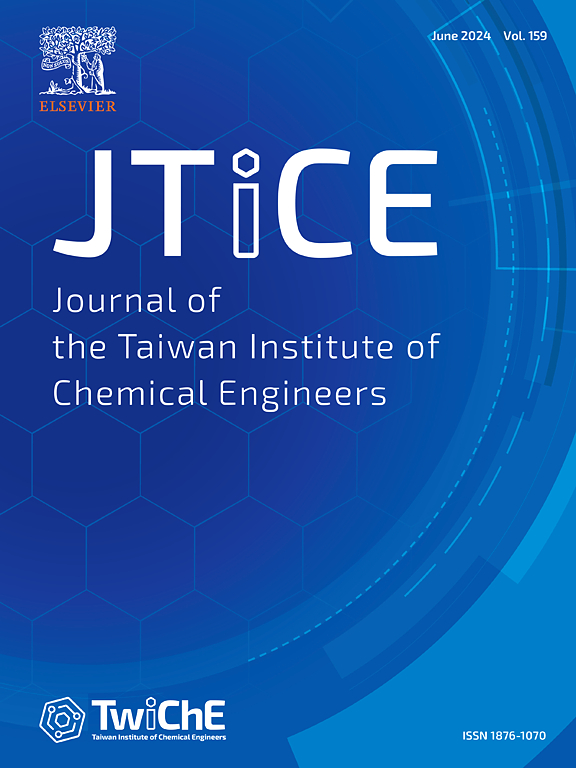Multilayer-coating process for the synthesis of nickel-silicate composite with high Ni loading as high-rate performance lithium-ion anode material
IF 5.5
3区 工程技术
Q1 ENGINEERING, CHEMICAL
Journal of the Taiwan Institute of Chemical Engineers
Pub Date : 2024-11-02
DOI:10.1016/j.jtice.2024.105814
引用次数: 0
Abstract
Background
Metal silicates possess several important advantages as electrode materials for lithium-ion batteries (LIBs), including straightforward synthesis, low cost, and high thermal stability. A green synthesis routes that are capable of increasing metal loading and reducing the impact on the environment are required.
Methods
A Ni-silicate with a multilayer structure and a Ni/Si molar ratio of 0.25 is first prepared using the co-precipitation method. The as-synthesized product is then repeatedly immersed in a Ni2+ solution to obtain Ni-silicate with the desired Ni contents (Ni/Si molar ratio: 0.50–2.00). Finally, the resulting Ni-silicate is reconstructed by hydrothermal treatment under various temperatures (70 °C, 100 °C, 150 °C) and durations (3 h and 24 h) to obtain Ni-phyllosilicate. The effects of the hydrothermal treatment temperature, hydrothermal time, and Ni/Si ratio on the structure, morphology, and surface area of the Ni-silicate composites are examined.
Significant Findings
The Ni-silicate with a Ni/Si ratio of 1.5 has a reversible capacity of 729 mAhg-1, which exceeds traditional graphite anodes (372 mAhg-1). Furthermore, the material exhibits a capacity retention of up to 80 % as the current density is increased from 0.025 Ag-1 to 0.5 Ag-1. Thus, the synthesized Ni-silicate composite is a promising candidate material for LIB anode.

用多层涂层工艺合成高镍含量的镍硅酸盐复合材料作为高倍率性能的锂离子负极材料
背景金属硅酸盐作为锂离子电池(LIB)的电极材料具有几个重要的优点,包括合成简单、成本低和热稳定性高。方法首先使用共沉淀法制备具有多层结构、镍/硅摩尔比为 0.25 的镍硅酸盐。然后将合成产物反复浸入 Ni2+ 溶液中,以获得所需 Ni 含量(Ni/Si 摩尔比:0.50-2.00)的镍硅酸盐。最后,在不同的温度(70 °C、100 °C、150 °C)和持续时间(3 小时和 24 小时)下,通过水热处理对得到的镍硅酸盐进行重构,以获得非硅酸镍。研究了水热处理温度、水热处理时间和 Ni/Si 比对镍硅酸盐复合材料的结构、形态和表面积的影响。重要发现 Ni/Si 比为 1.5 的镍硅酸盐的可逆容量为 729 mAhg-1,超过了传统的石墨阳极(372 mAhg-1)。此外,当电流密度从 0.025 Ag-1 增加到 0.5 Ag-1 时,该材料的容量保持率高达 80%。因此,合成的镍硅酸盐复合材料是一种很有前途的 LIB 阳极候选材料。
本文章由计算机程序翻译,如有差异,请以英文原文为准。
求助全文
约1分钟内获得全文
求助全文
来源期刊
CiteScore
9.10
自引率
14.00%
发文量
362
审稿时长
35 days
期刊介绍:
Journal of the Taiwan Institute of Chemical Engineers (formerly known as Journal of the Chinese Institute of Chemical Engineers) publishes original works, from fundamental principles to practical applications, in the broad field of chemical engineering with special focus on three aspects: Chemical and Biomolecular Science and Technology, Energy and Environmental Science and Technology, and Materials Science and Technology. Authors should choose for their manuscript an appropriate aspect section and a few related classifications when submitting to the journal online.

 求助内容:
求助内容: 应助结果提醒方式:
应助结果提醒方式:


